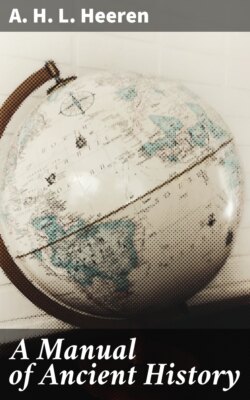Читать книгу A Manual of Ancient History - A. H. L. Heeren - Страница 19
На сайте Литреса книга снята с продажи.
EGYPTIANS.
ОглавлениеTable of Contents
Geography.
Preliminary remarks. Egypt in its superficial contents is equal to about two-thirds of Germany, and may therefore justly be ranked among the more extensive countries of the globe; it greatly varies, however, in its physical properties. The soil is only sufficiently fertile for tillage on the banks of the Nile, and as far as the floods of that river extend; beyond that, on the west, is a sandy desert, on the east a chain of rocky mountains. From its entrance into Egypt at Syene, Course of the Nile. the Nile flows in one undivided stream to the city of Cercasorus, 60 geogr. miles above its mouth, directing its source from south to north through a valley from 8 to 16 geogr. miles broad, bounded on the west by deserts of sand, and on the east by mountains of granite. At Cercasorus the stream first divides itself into two main branches, which formerly discharged their waters into the Mediterranean, the eastern near the city of Pelusium, the western near the city of Canopus (ostium Pelusiacum et Canopicum;) from these two diverged several intermediate branches; so that in the time of Herodotus there existed seven mouths of the Nile, but the number has not always remained the same. The tract between the two extreme arms of the Nile bears, in consequence of its triangular form, the name of the Delta; it was covered with cities, and highly cultivated. The fertile part of Egypt, inhabited by civilized men, was therefore confined to the Delta and the valley of the Nile, on the two banks of the stream from Syene to Cercasorus; to which must be added some well watered spots in the centre of the western desert, known under the name of the Oases. In consequence of the perpetual absence of rain, particularly in Upper Egypt, the fertility of the Delta and the valley of the Nile depends on the overflowing of the river, which happens at stated periods. This commences at the beginning of August and continues to the end of October; so that during three whole months the above-mentioned parts of the country are under water.
Divisions of Egypt.
Egypt is divided into Upper, extending from Syene to the city of Chemmis, (capital, Thebes, or Diospolis); Central from Chemmis to Cercasorus, (capital, Memphis,) and Lower Egypt, which comprises the Delta, and the land on both sides: it was full of cities, among which the most remarkable was Sais.
Ethiopia.
Next above Egypt lies Ethiopia, (Æthiopia supra Ægyptum); which, from the earliest times, principally through commerce, appears to have been closely connected with the former country. The regions immediately above Egypt, usually called Nubia, are little more than deserts of sand, still inhabited by roving hordes of nomad robbers. The rocky mountain chain, which forms the eastern boundary of Egypt, stretches along the Red sea, and was formerly of great importance to Nubia, from its containing, just above the Egyptian frontier, productive gold mines. The Nile, in this country, makes a wide curve to the west, and becomes so full of shallows as to render navigation difficult. The lands adjoining the river, however, are fertile and well inhabited; and contain numerous ancient monuments. Still higher up, reckoning from 16° N. lat. the appearance of the country changes; the region of fertility commences, and its costly productions, its gold and its perfumes, gave rise to a profitable commerce. Among these countries, Meroe, with its capital of the same name, was celebrated in the days of Herodotus. By Meroe is understood a tract of land bounded by two rivers, the Nile on the west, and the Astaboras, (Tacazze,) which falls into the Nile, on the east; for this reason it is frequently, although improperly, called an island. This country extended towards the sources of the Nile, or the modern province of Gojam, where, under the reign of Psammetichus, the Egyptian caste of warriors, having for the most part deserted, established themselves. Meroe itself, like the Egyptian states, was sacerdotal, with a king at its head.—The city of Axum, or Auxume, is not indeed mentioned at so early a period; but if we may judge by the ruins that still remain, it was of equally high antiquity with the old Egyptian towns and with Meroe. The same observations apply to Adule, the harbour on the Arabian gulf.
Divisions of Egyptian history.
The Egyptian history is divided into three periods of unequal duration; the first of which extends from the earliest time down to the Sesostridæ, that is to say, to about BC 1500: the second comprises the reigns of the Sesostridæ, or the brilliant period of Egypt, down to Psammetichus, 1500—650: the third brings us from Psammetichus down to the Persian conquest, 650—525.
